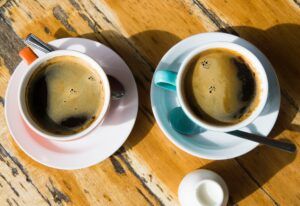Last updated on October 26th, 2023 at 19:58
Learning how to make a cafezinho will perhaps bring back memories of the bustling beaches of Brazil and that summer holiday or honeymoon to the South American nation and the enjoyable and famous Brazilian coffee.
Keep reading for a great and easy-to-follow Brazilian coffee recipe with step-by-step instructions.
How To Make A Cafezinho
Table Of Contents
- 1 How To Make A Cafezinho
- 2 What Is A Cafezinho Coffee
- 3 Cafezinho Meaning In English
- 4 Cafezinho Pronunciation
- 5 How To Make A Cafezinho Like Brazilian Barista
- 6 Frequently Asked Questions About How To Make A Cafezinho
- 6.1 How Is Brazilian Coffee Made?
- 6.2 Why Does Brazilian Coffee Taste Different?
- 6.3 What Is Brazil’s Traditional Coffee?
- 6.4 Is Brazilian Coffee The Best In The World?
- 6.5 Is Brazilian Coffee High In Caffeine?
- 6.6 What Do Brazilians Drink Coffee With?
- 6.7 What Are Some Fun Facts About Brazilian Coffee?
- 6.8 What Flavours Are in Brazil Coffee?
- 7 Final Thoughts – How To Make A Cafezinho
A cafezinho is super easy to make and requires no special equipment other than perhaps a cotton coffee sock, of which I often call a flannel coffee sock.
For an authentic cafezinho use rapadura and Brazilian beans. No excuses, Brazilian coffee is not exactly hard to find!

Read: What does cafezinho taste like?
What Is A Cafezinho Coffee
A cafezinho is a traditional and very popular Brazilian coffee drink that is served everywhere! Cafezinho is as much a part of Brazilian culture as soccer (Football), beautiful women and stunning beaches!
It’s the national coffee drink made with rapadura, a Brazilian unrefined sugar, Brazilian coffee bean and filtered through a flannel coffee sock. It’s usually served black with Brazilians often enjoying a morning cafezinho with a splash of milk or cream.
Cafezinho Meaning In English
Cafezinho means little coffee. It’s an amalgamation of café meaning coffee and the suffix zinho which is a diminutive and thus cafezinho means small coffee.
Cafezinho Pronunciation
Cafezinho is very easy to pronounce for English speakers and speakers of other European languages. Café is a word that you already know how to pronounce.
Pronounce the first part of cafezinho in the same way that you would pronounce café and then add zinho which is pronounced “zeen yo:. Say it all together, and you have the perfect pronunciation of cafezinho.
How To Make A Cafezinho Like Brazilian Barista
The traditional way of making this Brazilian coffee uses the full immersion method of extracting the coffee’s flavor and aroma.
Finely ground coffee of an espresso grind is immersed in sweet hot water that has rapadura dissolved in it. The coffee is then added and stirred and then strained through a flannel coffee sock and dripped into a carafe.
The cotton flannel filter results in a more complex coffee with more oils than a paper filter getting into your brew.
Let’s get making this Brazilian coffee recipe with step-by-step instructions.

Read: What is Cafezinho?
Step One: Weigh And Grind Your Coffee
Using your digital coffee scale, weigh 15 grams of Brazilian dark roasted whole coffee beans per cup of cafezinho that you wish to make. Grind your coffee beans to an espresso grind size using a ceramic conical burr grinder.
The better your beans, the better your coffee will be. Although café Bustelo can be used, it’s not a Brazilian coffee and thus for an authentic Brazilian cafezinho you should be using Brazilian coffee beans.
Step Two: Boil Your Water And Rapadura
Measure 4 ounces (120 ml) of water for each cup of cafezinho that you want to make.
Bring your water to a boil using a medium to high heat and add rapadura and stir well. One teaspoon of rapadura per cup of cafezinho brew is enough. Stir well to ensure that your rapadura is fully dissolved in your hot water.
Rapadura due to having a greater amount of molasses than refined sugar, adds a different flavor and depth of flavor to your beverage.
Step Three: Brew Your Cafezinho
Add your finely ground dark roast Brazilian coffee beans using 15 grams of coffee per cup that you are brewing.
The sharp and eagle eyed amongst you may have noted a coffee to water ratio of 1:8.
Take your saucepan off the heat and let it cool for 30 seconds to a minute until the temperature is no greater than 96C (205F). This is the maximum brewing temperature for coffee before your coffee gets over extracted and burnt notes in your coffee.
Add your coffee grounds and stir gently for a minute and leave it for a further four minutes to extract. Put a lit on your saucepan to prevent heat loss.
Step 4: Serve And Enjoy Your Cafezinho
When your cafezinho is ready and brewing has been completed, it is time to filter your cafezinho through a cloth flannel coffee sock. Pour your cafezinho slowly through a coffee sock and into a warm and preheated carafe and let it drip into your carafe.
When your carafe is full or all your coffee has filtered through the cotton coffee sock, serve your cafezinho from your coffee carafe into a 4-ounce (120 ml) coffee cup.
Enjoy it black if it is your first time trying the famous Brazilian coffee drink since this is how it is supposed to be enjoyed. After that first time, and if the taste of black coffee is not for you, add a splash of milk.
Frequently Asked Questions About How To Make A Cafezinho
How Is Brazilian Coffee Made?
Brazilian coffee is processed in different ways depending on the region and individual farm. The processes used in Brazil are wet processed (also known as washed), semi-washed (also known as pulp natural), dry processed (also known as natural). Brazil has the perfect climate for natural processing and thus the majority of their beans are natural processed.
A Brazilian cup of coffee is usually filter coffee made using a large flannel coffee sock. It’s a very common and popular brewing method all over Latin America.
Why Does Brazilian Coffee Taste Different?
Brazilian coffee tastes different due in kind to the low acidity and intense sweetness, heavy body and chocolate and caramel notes with a nice hint of nuttiness. The light acidity of Brazilian coffee often leads to many coffee lovers underestimating the quality of Brazilian coffee.
What Is Brazil’s Traditional Coffee?
Brazil’s traditional coffee is Cafezinho. It’s a small, strong filtered coffee that is drip-filtered using a large flannel sock. It’s brewed at a high temperature and sugar to sweeten what is a bitter tasting coffee.
Read: Cafezinho
Is Brazilian Coffee The Best In The World?
In my opinion, Brazilian coffee can definitely be considered as one of the best low altitude coffees due to the delicate and unique flavor profile. As the best in the world over all, in my opinion, Ethiopian, Tanzania and most certainly Panamania Geisha are much better.
Is Brazilian Coffee High In Caffeine?
No, Brazilian coffee is not highly caffeinated, they are not excessively weak either, just lower than normal and expected. Often Brazilian blends are mixed with beans that are more caffeinated or with Robusta beans to enhance the caffeine content.
What Do Brazilians Drink Coffee With?
Most Brazilians drink their coffee black and sweet. A lot of sugar is used to counteract the bitterness of the bean and the high temperature brewing process. Some add milk and cream. Generally, Brazilians like their coffee uncomplicated.
What Are Some Fun Facts About Brazilian Coffee?
Here are some cool coffee facts about Brazilian coffee.
- There are almost a quarter of a million coffee farms in Brazil.
- Coffee accounts for over 60% of all exports.
- 80% of coffee grown in Brazil is Arabica.
- Brazil produces more coffee than the rest of the top 5 producers combined!
- Coffee is grown between 1800ft (548M) and 3600ft (1096M).
What Flavours Are in Brazil Coffee?
Flavor notes of Brazilian coffee are light nutty notes, caramel and chocolate. Sweet and low in acid.
Final Thoughts – How To Make A Cafezinho
The step-by-step instructions showing you how to make a cafezinho should have you making a perfect cafezinho at home and one that is exactly the same as what is made in Brazilian homes all over the rather large country.
Join our coffee community and share your Cafezinho creations, photos and your tips for beans to use with your fellow coffee lovers. Find us on Facebook/Meta.






![[Recipe] How To Make Dunkin Iced Coffee At Home Like A Pro!](https://lattelovebrew.com/wp-content/uploads/2022/04/Recipe-How-To-Make-Dunkin-Iced-Coffee-At-Home-Like-A-Pro-1024x576.jpg)
